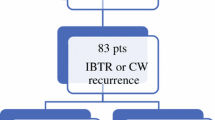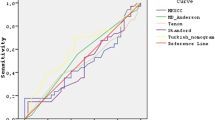Abstract
Background: Sentinel lymph node biopsy (SLNB) is gaining acceptance as an alternative to axillary lymph node dissection. The purpose of this study was to determine the frequency and pattern of disease recurrence after SLNB.
Methods: Two-hundred twenty-two consecutive patients undergoing SLNB from April 6, 1998, to October 27, 1999, and who were ≥24 months out from their procedure were identified from a prospectively maintained database. Retrospective chart review and data analysis were performed to identify variables predictive of recurrence.
Results: The median patient follow-up was 32 months (range, 24–43 months). A total of 159 patients (72%) were sentinel lymph node (SLN) negative and had no further axillary treatment. Five of these patients (3.1%) developed a recurrence (one local and four distant), with no isolated regional (axillary) recurrences. Sixty-three patients (28%) were SLN positive and underwent a subsequent axillary lymph node dissection. Six of these patients (9.5%) developed a recurrence (three local, one regional, and two distant). Pathologic tumor size (P < .001), lymphovascular invasion (P = .018), and a positive SLN (P = .048) were all statistically significantly associated with disease recurrence.
Conclusions:With a minimum follow-up of 24 months, patients with a negative SLN and no subsequent axillary treatment demonstrate a low frequency of disease recurrence. This supports the use of SLNB as the sole axillary staging procedure in SLN-negative patients.
Similar content being viewed by others
REFERENCES
Newman LA, Hunt KK, Buchholz T, et al. Presentation, management and outcome of axillary recurrence from breast cancer. Am J Surg 2000;180:252–6.
Morrow M. Is axillary dissection necessary after positive sentinel node biopsy? Yes!. Ann Surg Oncol 2001;8:74–6.
Krag DN, Weaver DL, Alex JC, Fairbank JT. Surgical resection and radiolocalization of the sentinel lymph node in breast cancer using a gamma probe. Surg Oncol 1993;2:335–9.
Giuliano AE, Kirgan DM, Guenther JM, Morton DL. Lymphatic mapping and sentinel lymphadenectomy for breast cancer. Ann Surg 1994;220:391–8.
Krag D, Weaver D, Ashikaga T, et al. The sentinel node in breast cancer: a multicenter validation study. N Engl J Med 1998;339:941–6.
Miltenburg DM, Miller C, Karamlou TB, Brunicardi FC. Meta-analysis of sentinel lymph node biopsy in breast cancer. J Surg Res 1999;84:138–42.
Noguchi M, Motomura K, Imoto S, et al. A multicenter validation study of sentinel lymph node biopsy by the Japanese Breast Cancer Society. Breast Cancer Res Treat 2000;63:31–40.
Veronesi U, Paganelli G, Viale G, et al. Sentinel lymph node biopsy and axillary dissection in breast cancer: results in a large series. J Natl Cancer Inst 1999;91:368–78.
Veronesi U, Paganelli G, Galimberti V, et al. Sentinel-node biopsy to avoid axillary dissection in breast cancer with clinically negative lymph nodes. Lancet 1997;349:1864–7.
Tafra L, Lannin DR, Swanson MS, et al. Multicenter trial of sentinel node biopsy for breast cancer using both technetium sulfur colloid and isosulfan blue dye. Ann Surg 2001;233:51–9.
Reynolds C, Mick R, Donohue JH, et al. Sentinel lymph node biopsy with metastasis: can axillary dissection be avoided in some patients with breast cancer? J Clin Oncol 1999;17:1720–6.
Cox CE, Bass SS, McCann CR, et al. Lymphatic mapping and sentinel lymph node biopsy in patients with breast cancer. Annu Rev Med 2000;51:525–42.
Borgstein PJ, Pijpers R, Comans EF, et al. Sentinel lymph node biopsy in breast cancer: guidelines and pitfalls of lymphoscintigraphy and gamma probe detection. J Am Coll Surg 1998;186:275–83.
Haigh PI, Hansen NM, Qi K, Giuliano AE. Biopsy method and excision volume do not affect success rate of subsequent sentinel lymph node dissection in breast cancer. Ann Surg Oncol 2000;7:21–7.
Kollias J, Gill PG, Chatterton BE, et al. Reliability of sentinel node status in predicting axillary lymph node involvement in breast cancer. Med J Aust 1999;171:461–5.
Hill AD, Tran KM, Adhusrt T, et al. Lessons learned from 500 cases of lymphatic mapping for breast cancer. Ann Surg 1999;229:528–35.
McMasters KM, Tuttle TM, Carlson DJ, et al. Sentinel lymph node biopsy for breast cancer: a suitable alternative to routine axillary dissection in multi-institutional practice when optimal technique is used. J Clin Oncol 2000;18:2560–6.
Zervos EE, Burak WE. Lymphatic mapping for breast cancer: experience at The Ohio State University. Breast Cancer 2000;7:195–200.
Povoski SP, Dauway EL, Ducatman BS. Sentinel lymph node mapping and biopsy for breast cancer at a rural-based university medical center: initial experience with intraparenchymal and intradermal injection routes. Breast Cancer 2002;9:134–44.
Giuliano AE, Haigh PI, Brennan MB, et al. Prospective observational study of sentinel lymphadenectomy without further axillary dissection in patients with sentinel node-negative breast cancer. J Clin Oncol 2000;18:2553–9.
Singletary SE. Surgical management of early-stage breast cancer. Gen Surg News 2001;Feb:17–24.
Zurrida S, Orecchia R, Galimberti V, et al. Axillary radiotherapy instead of axillary dissection: a randomized trial. Ann Surg Oncol 2002;9:156–60.
Dowlatshahi K, Fan M, Bloom K, et al. Occult metastases in the sentinel lymph nodes of patients with early stage breast carcinoma. Cancer 1999;86:990–6.
Ross MI. Sentinel node dissection in early-stage breast cancer: ongoing prospective randomized trials in the USA. Ann Surg Oncol 2001;8(9 Suppl):77S–81S.
Author information
Authors and Affiliations
Corresponding author
Rights and permissions
About this article
Cite this article
Badgwell, B.D., Povoski, S.P., Abdessalam, S.F. et al. Patterns of Recurrence After Sentinel Lymph Node Biopsy for Breast Cancer. Ann Surg Oncol 10, 376–380 (2003). https://doi.org/10.1245/ASO.2003.07.026
Received:
Accepted:
Issue Date:
DOI: https://doi.org/10.1245/ASO.2003.07.026




